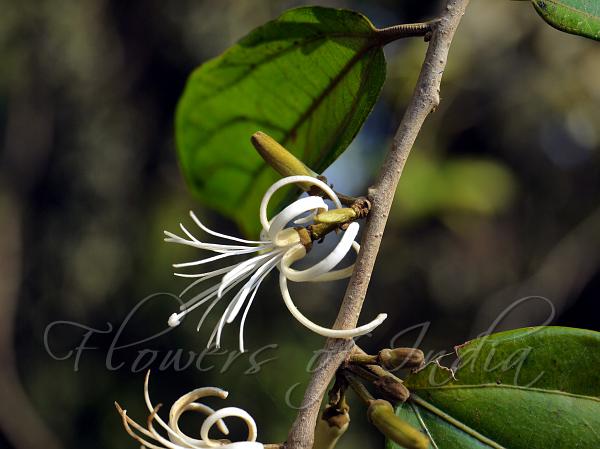|
| Climbing Alangium |
|

|

| File size | 691176 |
| Original date | 3/16/13 9:16 AM |
| Resolution | 4000 x 3000 |
| Flash | Flash did not fire, auto |
| Focal length | 45.0mm |
| Exposure time | 1/500s |
| Aperture | 5.0 |
| Focus Distance | |
| Metering Mode | Spot |
| Camera make | Panasonic |
| Camera model | DMC-G1 |
| Sensor type | OneChipColorArea |
|
|
|
|
Photo: |
Botanical name: Alangium hexapetalum Family: Cornaceae (Dogwood family)
Synonyms: Alangium salviifolium var. hexapetalum, Alangium salviifolium subsp. hexapetalum
Synonyms: Alangium salviifolium var. hexapetalum, Alangium salviifolium subsp. hexapetalum
Climbing Alangium is a straggling, armed evergreen
shrub with leaves 13-18 x 5-7 cm, obovate-oblong, tip tapering, base
round to somewhat heart-shaped, nerves 5 pairs, lowest pair from the
base, rib-like; nervules netveined, almost parallel; leaf-stalk up to 1
cm long. Flowers are 2 cm long, borne in fascicles in leaf-axils.
Flower-stalks are 8 mm long velvet-hairy; sepal-cup cup-shaped, 5 mm
across, 7-teethed, densely woolly. Petals are 7, each 17 x 2 mm,
linear-oblong, woolly; stamens 14, filaments 8 mm long, fringed with
hairs below; anthers 7 mm long, linear; ovary inferior, 1-celled, ovule
solitary, style 1, elongate, stigma capitate. Berry is 2 x 1.3 cm,
ellipsoid, woolly. Climbing Alangium is found in South India and Sri
Lanka. Flowering: March-August.
| Identification credit: Dinesh Valke | Photographed in Salkod, Karnataka. |
• Is this flower misidentified? If yes,